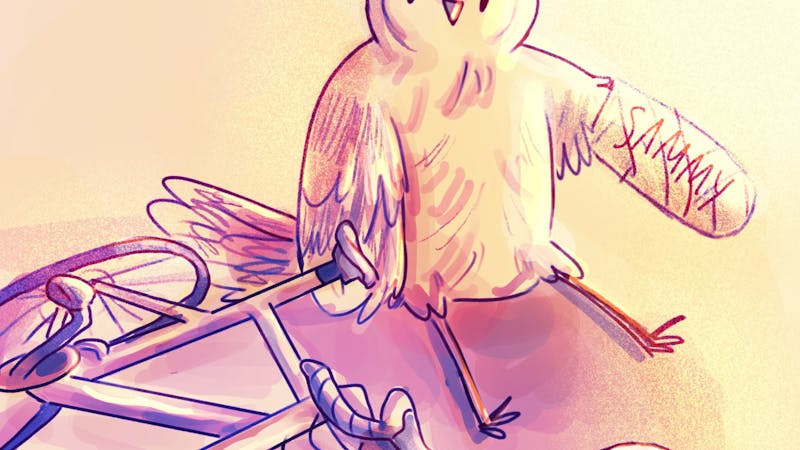Students, staff, Elvis impersonators take on the marathon

Members of Rice and the Houston community participated in the Houston Marathon last Sunday. Andy Liu / Thresher
Last Sunday morning, Rice students, staff and graduates brushed by the hedges at the Chevron Houston Marathon. The chilly weather and light breeze were perfect weather for running such a race, and if Lovetters and Sidizens happened to look outside their window that Sunday, they might have seen some of the 34,000 participants, the neon jersey of a pacer or even a priest throwing holy water onto the participants.
Gustavo Raskosky, a video and photography specialist for the Office of Public Affairs, said that marathons allow him to see Houston in a different light.
“Running marathons is great because you get to experience the totality of different cities,” Raskosky said. “I think running is a cool sport in general because it is the quickest way to explore a city. When I travel, I run around town.”
For Raskosky, running is also a way to connect with others. In 2022, he ran the Boston Marathon with three other runners of varying backgrounds. In Sunday’s marathon, he ran with a University of Texas Arlington student whom he met on Strava, a physical exercise tracking app.
Reyner Daniel Vargas Gamboa has also found a community in long-distance running. First beginning his training a year ago, he began to run as a way to assuage the stresses of school.
“I was looking to try something new, and I felt like there was a big running community in Houston … that empowered me to keep going on,” Vargas Gamboa, a graduate student at Rice, said. “It’s crazy — people from all ages are in running clubs, there’s Rice [undergraduates], and then people that are doctors or engineers.”
Vargas Gamboa had broken his elbow a month ago, and after going through surgery, was afraid that he wouldn’t be able to run the Houston Marathon. “My goal was just to finish the marathon and maybe do like four hours,” Vargas Gamboa said. “Thankfully, I was able to do three hours and 40 minutes.”
Madison Roy, a Jones College senior, said she began long-distance running during the COVID-19 pandemic as a way to stay active outside. The Houston Marathon was the first half marathon she ran, a major achievement in her running career. While she was achieving her own fitness goals, the marathon also allowed her to give back to her community.
“I’m participating in the half marathon through a program called Run for a Reason, which allows runners to fundraise for a charity instead of paying an entry fee,” Roy said. “I’m raising [money] for an animal shelter called Friends for Life, and I’ve been volunteering with them for about two years now.”
After the race, Roy remarked on the race’s attractions.
“I think the spectators really made it,” Roy said. “There were some groups that were themed; there were Elvis impersonators … that’s pretty cool to see.”
Machele Aguilar, a Baker College junior, said she spontaneously signed up for the Houston Marathon after seeing her friend sign up for the half marathon.
“I wanted to prove to myself that I can do quite literally anything I set my mind to,” Aguilar wrote in an email to the Thresher. “A marathon seemed like an unattainable goal.”
Aguilar said that other marathon participants helped motivate her to finish the race.
“At mile 20, I wanted to stop and quit entirely,” Aguiar said. “Fellow runners stopped and told me to keep going, people along the sides started cheering my name.”
Spectators also found meaning in the marathon. Camilla de Alba and Agustin Del Campo came to cheer on de Alba’s brother, who was running the marathon for the second time.
“Seeing Houston come together is really nice, seeing people cheer each other on even if you don’t know them,” de Alba, a Jones College junior, said.
Del Campo said that he was impressed by the dedication and hard work of the marathon runners.
“For me, it’s just so impressive to see so many people come out because I don’t know how anyone would ever run 26 miles,” Del Campo, a Will Rice College senior, said.
For Raskosky, the Houston Marathon brings both spectators and runners together.
“This is a very supportive sport, meaning that most people, if not all, are very supportive, even your competition,” Raskosky said. “I think that that quote stands, that if you want to restore your faith in humanity, stand at the end of a marathon.”
More from The Rice Thresher

New student center to ‘complete’ central quad
Breezeways, arches and outdoor seating will abound at the Moody Center Complex for Student Life set to break ground May 8. The 75,000-square-foot complex was designed by architecture firm Olson Kundig and has an expected completion date of fall 2027.

Best study snacks to fuel your finals
Finals are creeping up on us, and that means hunting season for the best study snacks on and off campus. Below are some that are sure to see you through the most enigmatic paper prompts and puzzling practice questions.

Head over handlebars: a brief history of Beer Bike accidents
In the first heat of the women’s race in this year’s Beer Bike, Melissa Geng said she was biking faster than she ever had, adrenaline pumping through her veins. All was going well, until she crashed into the fence of the alumni viewing area at the turn of her second lap.

Please note All comments are eligible for publication by The Rice Thresher.